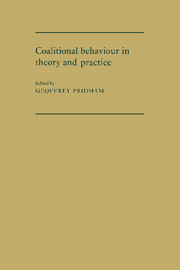Book contents
- Frontmatter
- Contents
- List of illustrations
- List of tables
- Notes on the contributors
- Preface
- 1 An inductive theoretical framework for coalitional behaviour: political parties in multi-dimensional perspective in Western Europe
- 2 Between theoretical elegance and political reality: deductive models and cabinet coalitions in Europe
- 3 Changing coalitional preferences among West German parties
- 4 The FDP and coalitional behaviour in the Federal Republic of Germany: multi-dimensional perspectives on the role of a pivotal party
- 5 Cabinet stability in the French Fourth Republic: the Ramadier coalition government of 1947
- 6 Coalition formation and maintenance in Belgium: a case-study of elite behaviour and changing cleavage structure, 1965–1981
- 7 The Dutch Christian Democratic party and coalitional behaviour in the Netherlands: a pivotal party in the face of depillarisation
- 8 Coalition or Fianna Fail? The politics of inter-party government in Ireland
- 9 Italy's party democracy and coalitional behaviour: a case-study in multi-dimensionality
- 10 Party coalitions in the first democratic period in Spain, 1977–1982
- 11 Coalitional theory and practice in Scandinavia
- 12 Multi-dimensional approaches to the study of local coalitions: some cross-national comparisons
- 13 Research notes
- Index
11 - Coalitional theory and practice in Scandinavia
Published online by Cambridge University Press: 05 November 2011
- Frontmatter
- Contents
- List of illustrations
- List of tables
- Notes on the contributors
- Preface
- 1 An inductive theoretical framework for coalitional behaviour: political parties in multi-dimensional perspective in Western Europe
- 2 Between theoretical elegance and political reality: deductive models and cabinet coalitions in Europe
- 3 Changing coalitional preferences among West German parties
- 4 The FDP and coalitional behaviour in the Federal Republic of Germany: multi-dimensional perspectives on the role of a pivotal party
- 5 Cabinet stability in the French Fourth Republic: the Ramadier coalition government of 1947
- 6 Coalition formation and maintenance in Belgium: a case-study of elite behaviour and changing cleavage structure, 1965–1981
- 7 The Dutch Christian Democratic party and coalitional behaviour in the Netherlands: a pivotal party in the face of depillarisation
- 8 Coalition or Fianna Fail? The politics of inter-party government in Ireland
- 9 Italy's party democracy and coalitional behaviour: a case-study in multi-dimensionality
- 10 Party coalitions in the first democratic period in Spain, 1977–1982
- 11 Coalitional theory and practice in Scandinavia
- 12 Multi-dimensional approaches to the study of local coalitions: some cross-national comparisons
- 13 Research notes
- Index
Summary
The Scandinavian area and coalition politics
In line with our re-evaluation of classic coalition theory and the need for a broader-based approach to the subject, the unity of the Scandinavian area (Denmark, Norway and Sweden) has a special attraction. Treating the Scandinavian area as a single entity enables a cross-national comparative analysis to be undertaken with greater assurance than between countries with less similarity. Furthermore, the Scandinavian area is a rich ‘laboratory’ for coalitional research. This area offers the broadest possible range of types of coalition and of nuances in coalitional behaviour. At the same time, it offers numerous examples of cases where the process of government formation could have followed the precepts of classic coalition theory, but in fact did not; with the prospect of holding office, parties often did not choose to do so. With the potential for forming closed minimum winning coalitions, the parties – perversely from the point of view of traditional coalition theory – preferred other alternatives, such as minority coalitions or minority governments, with or without stable external support. This must be strong prima facie evidence that classic theory has overrated the importance of certain dimensions, such as propensity to hold office, size and even contiguity, whilst not adequately integrating other factors related to the party system as a whole into the analysis. This is how the general mandate for the book seems to apply to Scandinavia, whose relevance to our common theme lies in these basic facts, which we shall attempt to amplify, codify and evaluate.
- Type
- Chapter
- Information
- Coalitional Behaviour in Theory and PracticeAn Inductive Model for Western Europe, pp. 251 - 277Publisher: Cambridge University PressPrint publication year: 1986

